Shoreline Displacement, Coastal Environments and Human Subsistence in the Hanö Bay Region during The Mesolithic
Abstract
1. Introduction
2. Geology and Archaeology: Regional Setting
3. Materials and Methods
4. Results
5. Discussion
5.1. The Yoldia Sea Lowstand (c. 11,500–10,800 cal BP)
5.2. The Ancylus Lake Transgression (c. 10,800–10,300 cal BP)
5.3. The Ancylus Lake Maximum (c. 10,300–9800 cal BP)
5.4. The Initial Littorina Sea Minimum (c. 9800–8500 cal BP)
5.5. The Littorina Sea Transgression (8500–6000 cal BP)
6. Conclusions
Author Contributions
Funding
Acknowledgments
Conflicts of Interest
References
- Andrén, T.; Björck, S.; Andrén, E.; Conley, D.; Zillén, L.; Anjar, J. The Development of the Baltic Sea Basin During the Last 130 Ka. In The Baltic Sea Basin; Harff, J., Björck, S., Hoth, P., Eds.; Springer: Heidelberg, Germany, 2011; pp. 75–98. [Google Scholar]
- Björck, S. A Review of the History of the Baltic Sea, 13.0–8.0 Ka BP. Quat. Int. 1995, 27, 19–40. [Google Scholar] [CrossRef]
- Rosentau, A.; Bennike, O.; Uścinowicz, S.; Miotk-Szpiganowicz, G. The Baltic Sea Basin. In Submerged Landscapes of the European Continental Shelf. Quaternary Paleoenvironments; Flemming, N.C., Harff, J., Moura, D., Burgess, A., Bailey, G., Eds.; Wiley Blackwell: Chichester, UK, 2017; pp. 103–134. [Google Scholar]
- Fischer, A. Coastal Fishing in Stone Age Denmark—Evidence from Below and above the Present Sea Level and from Human Bones. In Shell Middens and Coastal Resources along the Atlantic; Milner, N., Bailey, G., Craig, O., Eds.; Oxbow Books: Oxford, UK, 2007; pp. 54–69. [Google Scholar]
- Goldhammer, J.; Hartz, S. Fished up from the Baltic Sea: A New Ertebölle Site near Stohl Cliff, Kiel Bay, Germany. In Under the Sea: Archaeology and Palaeolandscapes of the Continental Shelf; Bailey, G.N., Harff, J., Sakellariou, D., Eds.; Springer: Cham, Switzerland, 2017; pp. 145–154. [Google Scholar]
- Hansson, A.; Björck, S.; Heger, K.; Holmgren, S.; Linderson, H.; Magnell, O.; Nilsson, B.; Rundgren, M.; Sjöström, A.; Hammarlund, D. Shoreline Displacement and Human Resource Utilization in the Southern Baltic Basin Coastal Zone During the Early Holocene: New Insights from a Submerged Mesolithic Landscape in South-Eastern Sweden. Holocene 2018, 28, 721–737. [Google Scholar] [CrossRef]
- Hansson, A.; Nilsson, B.; Sjöström, A.; Björck, S.; Holmgren, S.; Linderson, H.; Magnell, O.; Rundgren, M.; Hammarlund, D. A Submerged Mesolithic Lagoonal Landscape in the Baltic Sea, Southeastern Sweden—Early Holocene Environmental Reconstruction and Shore-Level Displacement Based on a Multiproxy Approach. Quat. Int. 2018, 463, 110–123. [Google Scholar] [CrossRef]
- Hartz, S.; Jöns, H.; Lübke, H.; Schmölcke, U.; von Carnap-Bornheim, C.; Heinrich, D.; Klooß, S.; Lüth, F.; Wolters, S. Prehistoric Settlements in the South-Western Baltic Sea Area and Development of the Regional Stone Age Economy. In Sincos II—Sinking Coasts: Geosphere, Ecosphere and Anthroposphere of the Holocene Southern Baltic Sea; Harff, J., Lüth, F., Eds.; Verlag Philipp von Zabern: Darmstadt, Germany, 2014; pp. 77–210. [Google Scholar]
- Uścinowicz, S.; Miotk-Szpiganowicz, G.; Krapiec, M.; Witak, M.; Harff, J.; Lübke, H.; Tauber, F. Drowned Forests in the Gulf of Gdańsk (Southern Baltic) as an Indicator of the Holocene Shoreline Changes. In The Baltic Sea Basin; Harff, J., Björck, S., Hoth, P., Eds.; Springer: Heidelberg, Germany, 2011; pp. 219–231. [Google Scholar]
- Mikaelsson, J. Strandvallskomplexet Vid Olsäng. Blekinges Natur 1978, 1, 37–52. [Google Scholar]
- Munthe, H. Beskrifning Till Kartbladet Ottenby; Serie Ac 7; Sveriges Geologiska Undersökning: Stockholm, Sweden, 1902; p. 68.
- Muru, M.; Rosentau, A.; Preusser, F.; Plado, J.; Sibul, I.; Joelath, A.; Bjursäter, S.; Aunap, R.; Kriiska, A. Reconstructing Holocene Shore Displacement and Stone Age Palaeogeography from a Foredune Sequence on Ruhnu Island, Gulf of Riga, Baltic Sea. Geomorphology 2018, 303, 434–445. [Google Scholar] [CrossRef]
- Rosentau, A.; Muru, M.; Kriiska, A.; Subetto, D.A.; Vassiljev, J.; Hang, T.; Gerasimov, D.; Nordqvist, K.; Ludikova, A.; Lougas, L.; et al. Stone Age Settlement and Holocene Shore Displacement in the Narva-Luga Klint Bay Area, Eastern Gulf of Finland. Boreas 2013, 42, 912–931. [Google Scholar] [CrossRef]
- Tikkanen, M.; Oksanen, J. Late Weichselian and Holocene Shore Displacement History of the Baltic Sea in Finland. Fennia 2002, 180, 9–20. [Google Scholar]
- Antonsson, K.; Seppä, H. Holocene Temperatures in Bohuslän, Southwest Sweden: A Quantitative Reconstruction from Fossil Pollen Data. Boreas 2007, 36, 400–410. [Google Scholar] [CrossRef]
- Seppä, H.; Hammarlund, D.; Antonsson, K. Low-Frequency and High-Frequency Changes in Temperature and Effective Humidity during the Holocene in South-Central Sweden: Implications for Atmospheric and Oceanic Forcings of Climate. Clim. Dyn. 2005, 25, 285–297. [Google Scholar] [CrossRef]
- Hammarlund, D.; Björck, S.; Buchardt, B.; Israelson, C.; Thomsen, C.T. Rapid Hydrological Changes During the Holocene Revealed by Stable Isotope Records of Lacustrine Carbonates from Lake Igelsjön, Southern Sweden. Quat. Sci. Rev. 2003, 22, 353–370. [Google Scholar] [CrossRef]
- Björck, S.; Rundgren, M.; Ingolfsson, O.; Funder, S. The Preboreal Oscillation around the Nordic Seas: Terrestrial and Lacustrine Responses. J. Quat. Sci. 1997, 12, 455–465. [Google Scholar] [CrossRef]
- Rasmussen, S.O.; Vinther, B.M.; Clausen, H.B.; Andersen, K.K. Early Holocene Climate Oscillations Recorded in Three Greenland Ice Cores. Quat. Sci. Rev. 2007, 26, 1907–1914. [Google Scholar] [CrossRef]
- Bos, J.A.A.; van Geel, B.; van der Plicht, J.; Bohncke, S.J.P. Preboreal Climate Oscillations in Europe: Wiggle-Match Dating and Synthesis of Dutch High-Resolution Multi-Proxy Records. Quat. Sci. Rev. 2007, 26, 1927–1950. [Google Scholar] [CrossRef]
- van der Plicht, J.; van Geel, B.; Bohncke, S.J.P.; Bos, J.A.A.; Blaauw, M.; Sperenza, A.O.M.; Muscheler, R.; Björck, S. The Preboreal Climate Reversal and a Subsequent Solar-Forced Climate Shift. J. Quat. Sci. 2004, 19, 263–269. [Google Scholar] [CrossRef]
- Fleitmann, D.; Mudelse, M.; Burns, S.J.; Bradley, R.S.; Kramers, J.; Matter, A. Evidence for a Widespread Climatic Anomaly at around 9.2 Ka before Present. Paleoceanography 2008, 23, PA1102. [Google Scholar] [CrossRef]
- Daley, T.J.; Thomas, E.R.; Holmes, J.A.; Street-Perrott, F.A.; Chapman, M.R.; Tindall, J.C.; Valdes, P.J.; Loader, N.J.; Marshall, J.D.; Wolff, E.W.; et al. The 8200 Yr BP Cold Event in Stable Isotope Records from the North Atlantic Region. Glob. Planet. Chang. 2011, 79, 288–302. [Google Scholar] [CrossRef]
- Kobashi, T.; Severinghaus, J.P.; Brooks, E.J.; Barnola, J.M.; Grachev, A.M. Precise Timing and Characterization of Abrupt Climate Change 8200 Years Ago from Air Trapped in Polar Ice. Quat. Sci. Rev. 2007, 26, 1212–1222. [Google Scholar] [CrossRef]
- Alley, R.B.; Ágústsdóttir, A.M. The 8k Event: Cause and Consequences of a Major Holocene Abrupt Climate Change. Quat. Sci. Rev. 2005, 24, 1123–1149. [Google Scholar] [CrossRef]
- Yu, S.Y.; Colman, S.M.; Lowell, T.V.; Milne, G.A.; Fisher, T.G.; Breckenridge, A.; Boyd, M.; Teller, J.T. Freshwater Outburst from Lake Superior as a Trigger for the Cold Event 9300 Years Ago. Science 2010, 328, 1262–1266. [Google Scholar] [CrossRef]
- Groß, D.; Zander, A.; Boethius, A.; Dreibrodt, S.; Grøn, O.; Hansson, A.; Jessen, C.; Koivisto, S.; Larsson, L.; Lübke, H.; et al. People, Lakes and Seashores: Studies from the Baltic Sea Basin and Adjacent Areas in the Early and Mid-Holocene. Quat. Sci. Rev. 2018, 185, 27–40. [Google Scholar] [CrossRef]
- Bohncke, S.J.P.; Hoek, W.Z. Multiple Oscillations during the Preboreal as Recorded in a Calcareous Gyttja, Kingbeekdal, the Netherlands. Quat. Sci. Rev. 2007, 26, 1965–1974. [Google Scholar] [CrossRef]
- Breivik, H.M.; Fossum, G.; Solheim, S. Exploring Human Responses to Climatic Fluctuations and Environmental Diversity: Two Stories from Mesolithic Norway. Quat. Int. 2018, 465, 258–275. [Google Scholar] [CrossRef]
- Crombé, P. Abrupt Cooling Events during the Early Holocene and Their Potential Impact on the Environment and Human Behaviour along the Southern North Sea Basin (NW Europe). J. Quat. Sci. 2018, 33, 353–367. [Google Scholar] [CrossRef]
- Griffiths, S.; Robinson, E. The 8.2 Ka BP Holocene Climate Change Event and Human Population Resilience in Northwest Atlantic Europe. Quat. Int. 2018, 465, 251–257. [Google Scholar] [CrossRef]
- Persson, C. Den Hemliga Sjön: En Resa Till Det Småländska Inlandet För 9000 År Sedan; Gothenburg Archaeological Theses: Gothenburg, Sweden, 2012; p. 294. [Google Scholar]
- Robinson, E.; Van Strydonck, M.; Gelorini, V.; Crombé, P. Radiocarbon Chronology and the Correlation of Hunteregatherer Sociocultural Change with Abrupt Palaeoclimate Change: The Middle Mesolithic in the Rhine-Meuse-Scheldt Area of Northwest Europe. J. Archaeol. Sci. 2013, 40, 755–763. [Google Scholar] [CrossRef]
- Wicks, K.; Mithen, S. The Impact of the Abrupt 8.2 Ka Cold Event on the Mesolithic Population of Western Scotland: A Bayesian Chronological Analysis Using ‘Activity Events’ as a Population Proxy. J. Archaeol. Sci. 2014, 45, 240–269. [Google Scholar] [CrossRef]
- De Geer, G. Om En Postglacial Landsänkning I Södra Och Mellersta Sverige; Serie C 52; Sveriges Geologiska Undersökning: Stockholm, Sweden, 1882; p. 16.
- Holst, N.O. Bidrag Till Kännedomen Om Östersjöns Och Bottniska Vikens Postglaciala Geologi; Serie C 180; Sveriges Geologiska Undersökning: Stockholm, Sweden, 1899; p. 128.
- Sandegren, R. Torvgeologisk Och Pollenanalytisk Undersökning Av Torvmarken N Intill Boplatskomplexet Vid Siretorp. In Stenåldersboplatserna Vid Siretorp I Blekinge; Bagge, A., Kjellmark, K., Eds.; Kungliga Vitterhets Historie och Antikvitets Akademien: Stockholm, Sweden, 1939; pp. 251–256. [Google Scholar]
- Nilsson, E. Om Södra Sveriges Senkvartära Historia. Geologiska Föreningen i Stockholm Förhandlingar 1953, 75, 155–246. [Google Scholar] [CrossRef]
- Berglund, B.E. The Post-Glacial Shore Displacement in Eastern Blekinge, Southeastern Sweden; Serie C 599; Sveriges Geologiska Undersökning: Stockholm, Sweden, 1964; p. 47.
- Björck, S. Late Weichselian Stratigraphy of Blekinge, SE Sweden, and Water Level Changes in the Baltic Ice Lake. Lundqua thesis 7. Ph.D. Thesis, Lund University, Lund, Sweden, 1979; p. 248. [Google Scholar]
- Björck, S. A Stratigraphic Study of Late Weichselian Deglaciation, Shore Displacement and Vegetation History in South-Eastern Sweden. Fossils Strata 1981, 14, 3–91. [Google Scholar]
- Liljegren, R. Paleoekologi Och Strandförskjutning I En Littorinavik Vid Spjälkö I Mellersta Blekinge. Lundqua Thesis 11. Ph.D. Thesis, Lund University, Lund, Sweden, 1982; p. 95. [Google Scholar]
- Berglund, B.E.; Sandgren, P.; Barnekow, L.; Hannon, G.; Jiang, H.; Skog, G.; Yu, S.H. Early Holocene History of the Baltic Sea, as Reflected in Coastal Sediments in Blekinge, Southeastern Sweden. Quat. Int. 2005, 130, 111–139. [Google Scholar] [CrossRef]
- Andrén, T.; Andrén, E.; Berglund, B.E.; Yu, S.H. New Insights on the Yoldia Sea Low Stand in the Blekinge Archipelago, Southern Baltic Sea. Geologiska Föreningen i Stockholm Förhandlingar 2007, 129, 277–285. [Google Scholar] [CrossRef]
- Yu, S.Y.; Berglund, B.E.; Sandgren, P.; Lambeck, K. Evidence for a Rapid Sea-Level Rise 7600 Yr Ago. Geology 2007, 35, 891–894. [Google Scholar] [CrossRef]
- Nilsson, T. Die Pollenanalyti-Sche Zonengliederung Der Spät- Und Postglazialen Bildungen Schonens. Geologiska Föreningen i Stockholm Förhandlingar 1935, 57, 385–562. [Google Scholar] [CrossRef]
- Berglund, B.E. Late-Quaternary Vegetation in Eastern Blekinge, South-Eastern Sweden. I. Late-Glacial Time; Opera Botanica 12:1; Almqvist & Wiksell: Stockholm, Sweden, 1966; p. 180. [Google Scholar]
- Berglund, B.E. Late-Quaternary Vegetation in Eastern Blekinge, South-Eastern Sweden. II. Post-Glacial Time; Opera Botanica 12:2; Almqvist & Wiksell: Stockholm, Sweden, 1966; p. 190. [Google Scholar]
- Gaillard, M.J. A Palaeohydrological Study of Krageholmssjön (Scania, South Sweden). Regional Vegetation History and Water-Level Changes; Lundqua Report 25; Lund University: Lund, Sweden, 1984; p. 40. [Google Scholar]
- Nilsson, T. Ravlundafältets Geologi. Skånes Natur 1961, 1, 73–106. [Google Scholar]
- Hansen, L. Hanöbuktens Forntida Miljö. Resultat Och Redovisning Av Marina Undersökningar Mellan Den 2—16 Juni 1985; Lars Hansen: Malmö, Sweden, 1985; p. 16. [Google Scholar]
- Hansen, L. Hanöbuktens Forntida Miljö. Forskningsprogram; Lars Hansen: Malmö, Sweden, 1986; p. 13. [Google Scholar]
- Björck, S.; Dennegård, B.; Sandgren, P. The Marine Stratigraphy of the Hanö Bay, SE Sweden, Based on Different Sediment Stratigraphic Methods. Geologiska Föreningen i Stockholm Förhandlingar 1990, 112, 265–280. [Google Scholar] [CrossRef]
- Gaillard, M.J.; Lemdahl, G. Early-Holocene Coastal Environments and Climate in Southeast Sweden: A Reconstruction Based on Macrofossils from Submarine Deposits. Holocene 1994, 4, 53–68. [Google Scholar] [CrossRef]
- Hansen, L. Submerged Mesolithic Landscapes. Preliminary Results from the Hanö Bay, Southern Baltic. In Man & Sea in the Mesolithic; Fischer, A., Ed.; Oxbow books: Oxford, UK, 1995; pp. 409–414. [Google Scholar]
- Holmlund, J.; Nilsson, B.; Rönnby, J. Joint Explorations of the Sunken Past. Examples of Maritime Archaeological Collaboration between Industry and Academia in the Baltic. In Under the Sea: Archaeology and Palaeolandscapes of the Continental Shelf; Bailey, G., Harff, J., Sakellariou, D., Eds.; Springer: Cham, Switzerland, 2017; pp. 53–63. [Google Scholar]
- Nilsson, B.; Sjöström, A. Ån På Havets Botten: Geologisk Bakgrund Och Arkeologisk Framtid För Havängsundersökningarna. Österlent 2013, 1, 19–21. [Google Scholar]
- Nilsson, B.; Sjöström, A.; Persson, P. Seascapes of Stability and Change: The Archaeological and Ecological Potential of Early Mesolithic Seascapes, with Examples from Haväng in the Southern Baltic, Sweden. In The Ecology of Early Settlement in Northern Europe—Conditions for Subsistence and Survival; Persson, P., Skar, B., Breivik, H.M., Riede, F., Jonsson, L., Eds.; Equinox: Sheffield, UK, 2018; pp. 335–352. [Google Scholar]
- Ågren, J.; Svensson, R. Postglacial Land Uplift Model and System Definition for the New Swedish Height System Rh 2000; Lmv-Rapport 2007:4; Lantmäteriet: Gävle, Sweden, 2007; p. 124.
- Ångström, A. Sveriges Klimat; Generalstabens Litografiska Anstalts Förlag: Stockholm, Sweden, 1974; p. 106. [Google Scholar]
- Kornfält, K.-A.; Bergström, J. Beskrivning Till Berggrundskartorna Karlshamn SV Och SO; Serie Af 167–168; Sveriges Geologiska Undersökning: Uppsala, Sweden, 1990; p. 74.
- Kornfält, K.-A. Beskrivning Till Berggrundskartan Karlskrona NV/SV; Serie Af 179; Sveriges Geologiska Undersökning: Uppsala, Sweden, 1993; p. 56.
- Kornfält, K.-A. Beskrivning Till Berggrundskartan 3f Karlskrona SO; Serie Af 205; Sveriges Geologiska Undersökning: Uppsala, Sweden, 1999; p. 59.
- Kornfält, K.-A. Beskrivning Till Berggrundskartan 3f Karlskrona NO; Serie Af 199; Sveriges Geologiska Undersökning: Uppsala, Sweden, 1999; p. 73.
- Erlström, M.; Sivhed, U.; Wikman, H.; Kornfält, K.-A. Beskrivning Till Berggrundskartorna 2d Tomelilla NV, NO, SV, SO 2e Simrishamn NV, SV 1d Ystad NV, NO 1e Örnhusen NV; Sveriges Geologiska Undersökning: Uppsala, Sweden, 2004; p. 141.
- Kornfält, K.-A.; Bergström, J.; Carserud, L.; Henkel, H.; Sundquist, B. Beskrivning Till Berggrundskartan Och Flygmagnetiska Kartan Kristianstad SO; Serie Af 121; Sveriges Geologiska Undersökning: Uppsala, Sweden, 1978; p. 120.
- Stroeven, A.P.; Hättestrand, C.; Kleman, J.; Heyman, J.; Fabel, D.; Fredin, O.; Goodfellow, B.W.; Harbor, J.M.; Jansen, J.D.; Olsen, L.; et al. Deglaciation of Fennoscandia. Quat. Sci. Rev. 2016, 147, 91–121. [Google Scholar] [CrossRef]
- Larsson, I. Anisotropy in Precambrian Rocks and Post-Crystalline Deformation Models. Geogr. Annal. Ser. A Phys. Geogr. 1967, 49, 237–246. [Google Scholar] [CrossRef]
- Persson, M. Beskrivning Till Jordartskartan 3e Karlshamn SO; Serie Ae 116; Sveriges Geologiska Undersökning: Uppsala, Sweden, 1995; p. 76.
- Persson, M. Beskrivning Till Jordartskartan 3e Karlshamn NO; Serie Ae 138; Sveriges Geologiska Undersökning: Uppsala, Sweden, 2000; p. 51.
- Persson, M.; Malmberg Persson, K. Beskrivning Till Jordartskartorna 3f Karlskrona NO Och SO; Serie K 532–533; Sveriges Geologiska Undersökning: Uppsala, Sweden, 2016; p. 74.
- Bagge, A.; Kjellmark, K. Stenåldersboplatserna Vid Siretorp I Blekinge; Kungliga Vitterhets Historie och Antikvitets Akademien: Stockholm, Sweden, 1939; p. 405. [Google Scholar]
- Kjällquist, M.; Friman, B. Ljungaviken Etapp 2, Yta A. Ett Överlagrat Boplatsområde Från Mellanmesolitikum; Rapport 2017:99; Arkeologerna: Lund, Sweden, 2017; p. 106. [Google Scholar]
- Karsten, P.; Nilsson, B. In the Wake of a Woman. The Stone Age Pioneering of North-Eastern Scania, Sweden, 10,000–5000 Bc. The Årup Settlements; Riksantikvarieämbetet: Stockholm, Sweden, 2006; p. 200.
- Wyszomirska, B. Ekonomisk Stabilitet Vid Kusten. Nymölla III. En Tidigneolitisk Bosättning Med Fångstekonomi I Nordöstra Skåne; Department of Archaeology, Lund University: Lund, Sweden, 1988; p. 212. [Google Scholar]
- Edring, A. Två Mesolitiska Kustboplatser Vid Yngsjö I Nordöstra Skåne. Fornvännen 2008, 103, 1–12. [Google Scholar]
- Malmberg Persson, K. Beskrivning Till Jordartskartan 2d Tomelilla NO; Serie Ae 135; Sveriges Geologiska Undersökning: Uppsala, Sweden, 2000; p. 71.
- Althin, C.A. The Chronology of the Stone Age Settlement of Scania, Sweden. I the Mesolithic Settlement; Acta Archaeologica Lundensia Series 4; Lund University: Lund, Sweden, 1954; p. 311. [Google Scholar]
- Andersson, M.; Knarrström, B. Senpaleolitikum I Skåne—En Studie Av Materiell Kultur Och Ekonomi Hos Sveriges Första Fångstfolk; Riksantikvarieämbetet: Stockholm, Sweden, 1999; p. 127.
- Erixon, S. Stenåldern I Blekinge. Fornvännen 1913, 8, 125–212. [Google Scholar]
- Wibling, C. Tiden För Blekinges Första Bebyggande. In Carlskrona Weckoblad, nr. 136; Carlskrona Weckobla: Karlskrona, Sweden, 16 November 1895. [Google Scholar]
- Wibling, C. Om Kustfynd Från Stenåldern I Blekinge. Ymer 1899; Svenska Sällskapet för Antropologi och Geografi 19: Stockholm, Sweden, 1900; p. 15. [Google Scholar]
- Lönnberg, E. Stenåldersboplatsen På Lasarettsområdet I Karlshamn. Blekingeboken 1930, 1, 2–24. [Google Scholar]
- Berglund, B.E. Pysslingebacken. En Östblekingsk Jägar- Och Fiskarboplats Från Yngre Stenåldern; Blekingeboken: Karlskrona, Sweden, 1960; p. 36. [Google Scholar]
- Nilsson, B. Tingens Och Tankarnas Landskap; Almqvist & Wiksell: Stockholm, Sweden, 2003; p. 368. [Google Scholar]
- Kjällquist, M.; Emilsson, A.; Boethius, A. Norje Sunnansund. Boplatslämningar Från Tidigmesolitikum Och Järnålder; Blekinge Museum Rapport 2014:10; Blekinge museum: Karlskrona, Sweden, 2016; p. 353. [Google Scholar]
- Boethius, A. Signals of Sedentism: Faunal Exploitation as Evidence of a Delayed-Return Economy at Norje Sunnansund, an Early Mesolithic Site in South-Eastern Sweden. Quat. Sci. Rev. 2017, 162, 145–168. [Google Scholar] [CrossRef]
- Reimer, P.J.; Bard, E.; Bayliss, A.; Beck, J.W.; Blackwell, P.G.; Ramsey, C.B.; Buck, C.E.; Cheng, H.; Edwards, R.L.; Friedrich, M.; et al. Intcal13 and Marine13 Radiocarbon Age Calibration Curves 0-50,000 Years Cal BP. Radiocarbon 2013, 55, 1869–1887. [Google Scholar] [CrossRef]
- Bronk Ramsey, C. Bayesian Analysis of Radiocarbon Dates. Radiocarbon 2009, 51, 337–360. [Google Scholar] [CrossRef]
- Bengtsson, L.; Enell, M. Chemical Analysis. In Handbook of Holocene Palaeoecology and Palaeohydrology; Berglund, B.E., Ed.; Wiley: Chichester, UK, 1986; pp. 423–451. [Google Scholar]
- Berglund, B.E.; Ralska-Jasiewiczowa, M. Pollen Analysis and Pollen Diagrams. In Handbook of Holocene Palaeoecology and Palaeohydrology; Berglund, B.E., Ed.; Wiley: Chichester, UK, 1986; pp. 455–484. [Google Scholar]
- Stockmarr, J. Tablets with Spores Used in Absolute Pollen Analysis. Pollen Spores 1971, 13, 615–621. [Google Scholar]
- Hansson, A.; Hammarlund, D.; Landeschi, G.; Sjöström, A.; Nilsson, B. A New Early Holocene Shoreline Displacement Record for Blekinge, Southern Sweden, and Implications for Underwater Archaeology. Boreas 2019, 48, 57–71. [Google Scholar] [CrossRef]
- Wijkmark, N.; Enhus, C.; Isaeus, M.; Lindahl, U.; Nilsson, L.; Nikolopoulos, A.; Nyström Sandman, A.; Näslund, J.; Sundblad, G.; Didrikas, T.; et al. Marin Inventering Och Modellering I Blekinge Län Och Hanöbukten; Länsstyrelsen Blekinge län: Karlskrona, Sweden, 2015; p. 168.
- Walker, M.; Johnsen, S.; Rasmussen, S.O.; Popp, T.; Steffensen, J.P.; Gibbard, P.; Hoek, W.; Andrews, J.; Björck, S.; Cwynar, L.C.; et al. Formal Definition and Dating of the GSSP (Global Stratotype Section and Point) for the Base of the Holocene Using the Greenland NGRIP Ice Core, and Selected Auxiliary Records. J. Quat. Sci. 2009, 24, 3–17. [Google Scholar] [CrossRef]
- Colbo, K.; Ross, T.; Brown, C.; Weber, T. A Review of Oceanographic Applications of Water Column Data from Multibeam Echosounders. Estuar. Coast. Shelf Sci. 2014, 145, 41–56. [Google Scholar] [CrossRef]
- Hansson, A. Submerged Landscapes in the Hanö Bay. Early Holocene Shoreline Displacement and Human Environments in the Southern Baltic Basin. Lundqua Thesis 85. Ph.D. Thesis, Lund University, Lund, Sweden, 2018; p. 146. [Google Scholar]
- Seppä, H. Pollen Analysis, Principles. In Encyclopedia of Quaternary Science; Elias, S., Ed.; Elsevier: Amsterdam, The Netherlands, 2007; pp. 794–804. [Google Scholar]
- Klingberg, F.; Påsse, T.; Holmgren, S. Projekt ”Kladdsjön—En Fornsjö I Västra Blekinges Farvatten”. Undersökning Av En Lagerföljd Vid Kladdarna För Att Belysa Strandförskjutningsförloppet I Hanöbukten; SGU Rapport 2007:3; Sveriges Geologiska Undersökning: Uppsala, Sweden, 2007; p. 55.
- Björk, T.; Henriksson, M.; Larsson, F.; Persson, C.; Rudebeck, E.; Åstrand, J. Lussabacken Norr. Boplatslämningar Från Mesolitikum, Neolitikum, Bronsålder Och Järnålder; Blekinge Museum Rapport 2014:9; Blekinge Museum: Karlskrona, Sweden, 2016; p. 409. [Google Scholar]
- Björk, T.; Knarrström, B.; Persson, C. Damm 6 Och Bro 597. Boplatslämningar Och En Hydda Från Tidigmesolitikum; Blekinge Museum: Karlskrona, Sweden, 2015; p. 182. [Google Scholar]
- Aaris-Sørensen, K. Danmarks Forhistoriske Dyreverden. Om Skovelefanter, Næsehorn, Bisoner, Urokser, Mammutter Og Kæmpehjorte; Gyldendal: Copenhagen, Denmark, 1998; p. 232. [Google Scholar]
- Aaris-Sørensen, K. Diversity and Dynamics of the Mammalian Fauna in Denmark throughout the Last Glacial-Interglacial Cycle, 115–0 Kyr BP. Fossils Strata 2009, 57, 1–59. [Google Scholar]
- Jessen, C.A.; Pedersen, K.B.; Christensen, C.; Olsen, J.; Mortensen, M.F.; Hansen, K.M. Early Maglemosian Culture in the Preboreal Landscape: Archaeology and Vegetation from the Earliest Mesolithic Site in Denmark at Lundby Mose, Sjælland. Quat. Int. 2015, 378, 73–87. [Google Scholar] [CrossRef]
- Møhl, U. Elsdyrskeletterne Fra Skottemarke Og Farvbo. Skik Og Brug Ved Borealtidens Jagter. Aarbøger for Nordisk Oldkyndighed Og Historie 1978; Det Kongelige Nordiske Oldskriftselskab: Copenhagen, Denmark, 1978; p. 32. [Google Scholar]
- Boethius, A. Fishing for Ways to Thrive: Integrating Zooarchaeology to Understand Subsistence Strategies and Their Implications among Early and Middle Mesolithic Southern Scandinavian Foragers; Acta Archaeologica Lundensia Series Altera in 8, No 70. Studies in Osteology 4; Lund University: Lund, Sweden, 2018; p. 172. [Google Scholar]
- Aaris-Sørensen, K.; Mühldorff, R.; Petersen, E.B. The Scandinavian Reindeer (Rangifer Tarandus L.) after the Last Glacial Maximum: Time, Seasonality and Human Exploitation. J. Archaeol. Sci. 2007, 34, 914–923. [Google Scholar] [CrossRef]
- Hartz, N.; Winge, H. Om Uroksen Fra Vig Saaret Og Dræbt Med Flintwaaben. Aarbøger for Nordisk Oldkyndighet Og Historie 1906; Det Kongelige Nordiske Oldskriftselskab: Copenhagen, Denmark, 1906. [Google Scholar]
- Noe-Nygaard, N.; Price, T.D.; Hede, S.U. Diet of Aurochs and Early Cattle in Southern Scandinavia: Evidence from 15N and 13C Stable Isotopes. J. Archaeol. Sci. 2005, 32, 855–871. [Google Scholar] [CrossRef]
- Arnesson-Westerdahl, A. Den Tidigmesolitiska Faunan Vid Hornborgasjön, Västergötland. Osteologisk Analys Av Djurbensmaterialet Från 1983 Års Arkeologiska Undersökningar På Almeö 96 B, Unpublished Report. 1984.
- Boethius, A. Huseby Klev and the Quest for Pioneer Subsistence Strategies: Diversification of a Maritime Lifestyle. In The Ecology of Early Settlement in Northern Europe—Conditions for Subsistence and Survival; Persson, P., Skar, B., Breivik, H.M., Riede, F., Jonsson, L., Eds.; Equinox Publishing: Sheffield, UK, 2018; pp. 99–128. [Google Scholar]
- Lagerås, P.; Broström, A.; Svensson, N.O. Insamling Av Ätliga Växter Och Ved under Mesolitikum: En Diskussion Baserad På Makrofossil Och Träkol Från Västra Blekinge; Blekinge museum: Karlskrona, Sweden, In preparation.
- Bendixen, C.; Jensen, J.B.; Boldreel, L.O.; Clausen, O.R.; Bennike, O.; Seidenkrantz, M.S.; Nyberg, J.; Hübscher, C. The Holocene Great Belt Connection to the Southern Kattegat, Scandinavia: Ancylus Lake Drainage and Early Littorina Sea Transgression. Boreas 2017, 46, 53–68. [Google Scholar] [CrossRef]
- Björck, S.; Andrén, T.; Jensen, J.B. An Attempt to Resolve the Partly Conflicting Data and Ideas on the Ancylus-Littorina Transition. Pol. Geol. Inst. Spec. Pap. 2008, 23, 21–26. [Google Scholar]
- Gedda, B. Terrestrial Mollusc Succession and Stratigraphy of a Holocene Calcareous Tufa Deposit from the Fyledalen Valley, Southern Sweden. Holocene 2006, 16, 137–147. [Google Scholar] [CrossRef]
- Gedda, B.; Lemdahl, G.; Gaillard, J.M. Lateglacial and Early Holocene Environments Inferred from a Tufa Deposit at Fyledalen, S. Sweden. Geologiska Föreningen i Stockholm Förhandlingar 1999, 121, 33–41. [Google Scholar] [CrossRef]
- Andrén, E.; Andrén, T.; Sohlenius, G. The Holocene History of the Southwestern Baltic Sea as Reflected in a Sediment Core from the Bornholm Basin. Boreas 2000, 29, 233–250. [Google Scholar] [CrossRef]
- Eriksson, M.; Magnell, O. Det Djuriska Tågerup. Nya Rön Kring Kongemose- Och Ertebøllekulturens Jakt Och Fiske. In Tågerup. Specialstudier; Karsten, P., Knarrström, B., Eds.; UV Syd, Avdelningen för arkeologiska undersökningar: Lund, Sweden, 2001; pp. 156–237. [Google Scholar]
- Magnell, O. Climate Change at the Holocene Thermal Maximum and Its Impact on Wild Game Populations in South Scandinavia. In Climate Change and Human Responses: A Zooarchaeological Perspective; Monks, G.G., Ed.; Springer: Dordrecht, The Netherlands, 2017; pp. 123–135. [Google Scholar]
- Boethius, A. The Use of Aquatic Resources by Early Mesolithic Foragers in Southern Scandinavia. In The Ecology of Early Settlement in Northern Europe—Conditions for Subsistence and Survival; Persson, P., Skar, B., Breivik, H.M., Riede, F., Jonsson, L., Eds.; Equinox Publishing: Sheffield, UK, 2018; pp. 311–334. [Google Scholar]
- Boethius, A.; Storå, J.; Hongslo, C.; Apel, J. The Importance of Freshwater Fish in Early Holocene Subsistence: Exemplified with the Human Colonization of the Island of Gotland in the Baltic Basin. J. Archaeol. Sci. 2017, 13, 625–634. [Google Scholar] [CrossRef]
- Boethius, A.; Ahlström, T. Fish and Resilience among Early Holocene Foragers of Southern Scandinavia: A Fusion of Stable Isotopes and Zooarchaeology through Bayesian Mixing Modelling. J. Archaeol. Sci. 2018, 93, 196–210. [Google Scholar] [CrossRef]
- Kullander, S.; Nyman, L.; Jilg, K.; Delling, B. Ryggsträngsdjur. Strålfeniga Fiskar. Chordata: Actinopterygii. Nationalnyckeln Till Sveriges Flora Och Fauna; SLU: Uppsala, Sweden, 2012; p. 517. [Google Scholar]
- Degerman, E.; Nyberg, P.; Näslund, I.; Jonasson, D. Ekologisk Fiskevård; Sportfiskarna, Sveriges Sportfiske-och Fiskevårdsförbund: Spånga, Sweden, 2002; p. 320. [Google Scholar]
- Boethius, A. Something Rotten in Scandinavia: The World’s Earliest Evidence of Fermentation. J. Archaeol. Sci. 2016, 66, 169–180. [Google Scholar] [CrossRef]
- Eidlitz, K. Food and Emergency Food in the Circumpolar Area; Almqvist & Wiksell: Uppsala, Sweden, 1969; p. 174. [Google Scholar]
- Davis, B.; Brewer, S.; Stevenson, A.; Guiot, J. The Temperature of Europe During the Holocene Reconstructed from Pollen Data. Quat. Sci. Rev. 2003, 22, 1701–1716. [Google Scholar] [CrossRef]
- Antonsson, K. Holocene Climate in Central and Southern Sweden: Quantitative Reconstructions from Fossil Data; Acta Universitatis Upsaliensis: Uppsala, Sweden, 2006; p. 37. [Google Scholar]
- Härkönen, T. Klimatförändringar—Så Påverkas Våra Sälar. In Havet 2011. Om Miljötillståndet I Våra Havsområden; Lewander, M., Karlsson, M., Lundberg, K., Eds.; Havsmiljöinstitutet: Gothenburg, Sweden, 2011; pp. 93–96. [Google Scholar]
- Magnell, O. The Seasonality of Hunting during the Mesolithic in South Scandinavia. In Proceedings of the Ninth International Conference on the Mesolithic in Europe, Belgrade, Serbia, 14–18 September 2015; Boric, D., Ed.; Submitted. [Google Scholar]
- Carter, R.J. Dental Indicators of Seasonal Human Presence at the Danish Boreal Sites of Holmegaard I, IV and V and Mullerup and the Atlantic Sites of Tybrind Vig and Ringkloster. Holocene 2001, 11, 359–365. [Google Scholar] [CrossRef]
- Rowley-Conwy, P. Season and Reason: The Case for a Regional Interpretation of Mesolithic Settlement Patterns. In Hunting and Animal Exploitation in the Later Palaeolithic and Mesolithic of Eurasia; Peterkin, G.L., Bricker, H., Mellars, P., Eds.; American Anthropological Association: Washington, DC, USA, 1993; pp. 179–188. [Google Scholar]
- Lagerås, P. Analyser Av Makrofossil Och Träkol. In Ljungaviken Etapp 2, Yta A. Ett Överlagrat Boplatsområde Från Mellanmesolitikum; Rapport 2017:99; Kjällquist, M., Friman, B., Eds.; Arkeologerna: Lund, Sweden, 2017; pp. 27–31. [Google Scholar]
- Larsson, L. From the Depth of the Sea: A Mesolithic Harpoon from the Baltic Sea. In Den Bogen Spannen... Festschrift Für Bernhard Gramsch. Beiträge Zur Ur- Und Frühgeschichte Mitteleuropas 21; Cziesla, F., Kersting, T., Pratsch, S., Eds.; Beier & Beran: Weisbach, Germany, 1999; pp. 169–175. [Google Scholar]
- Jonsson, L. Arkeozoologisk Identifiering Av Benfynd Från En Omlagrad Ertebölleboplats—Yngsjö 5:31, Åhus Socken I Kristianstads Kommun, Skåne; Länsmuseet i Kristianstad: Kristianstad, Sweden, 1997. [Google Scholar]
- Sjöström, A. Ringsjöholm—A Boreal-Early Atlantic Settlement in Central Scania, Sweden. Lund Archaeol. Rev. 1997, 3, 5–20. [Google Scholar]
- Solheim, S.; Persson, P. Early and Mid-Holocene Coastal Settlement and Demography in Southeastern Norway: Comparing Distribution of Radiocarbon Dates and Shoreline-Dated Sites, 8500–2000 Cal. Bce. J. Archaeol. Sci. 2018, 19, 334–343. [Google Scholar] [CrossRef]
- Berglund, B.E.; Welinder, S. Stratigrafin Vid Siretorp. In Fornvännen; Kungliga Vitterhets Historie och Antikvitets Akademien: Stockholm, Sweden, 1972; pp. 73–93. [Google Scholar]
- Persson, C. Arkeologiska Förundersökningar I Mörby 2014–2015, Raä 73 Mjällby Sn, Siretorp 3:2 M Fl., Mjällby Socken, Sölvesborgs Kommun, Blekinge Län; Blekinge Museum Rapport 2016:3; Blekinge Museum: Karlskrona, Sweden, 2016; p. 52. [Google Scholar]
- Henriksson, M. Siretorpsområdet, Mjällby Socken, Sölvesborgs Kommun. Arkeologisk Översiktsstudie; Blekinge Museum Rapport 2004:7; Blekinge museum: Karlskrona, Sweden, 2004; p. 8. [Google Scholar]
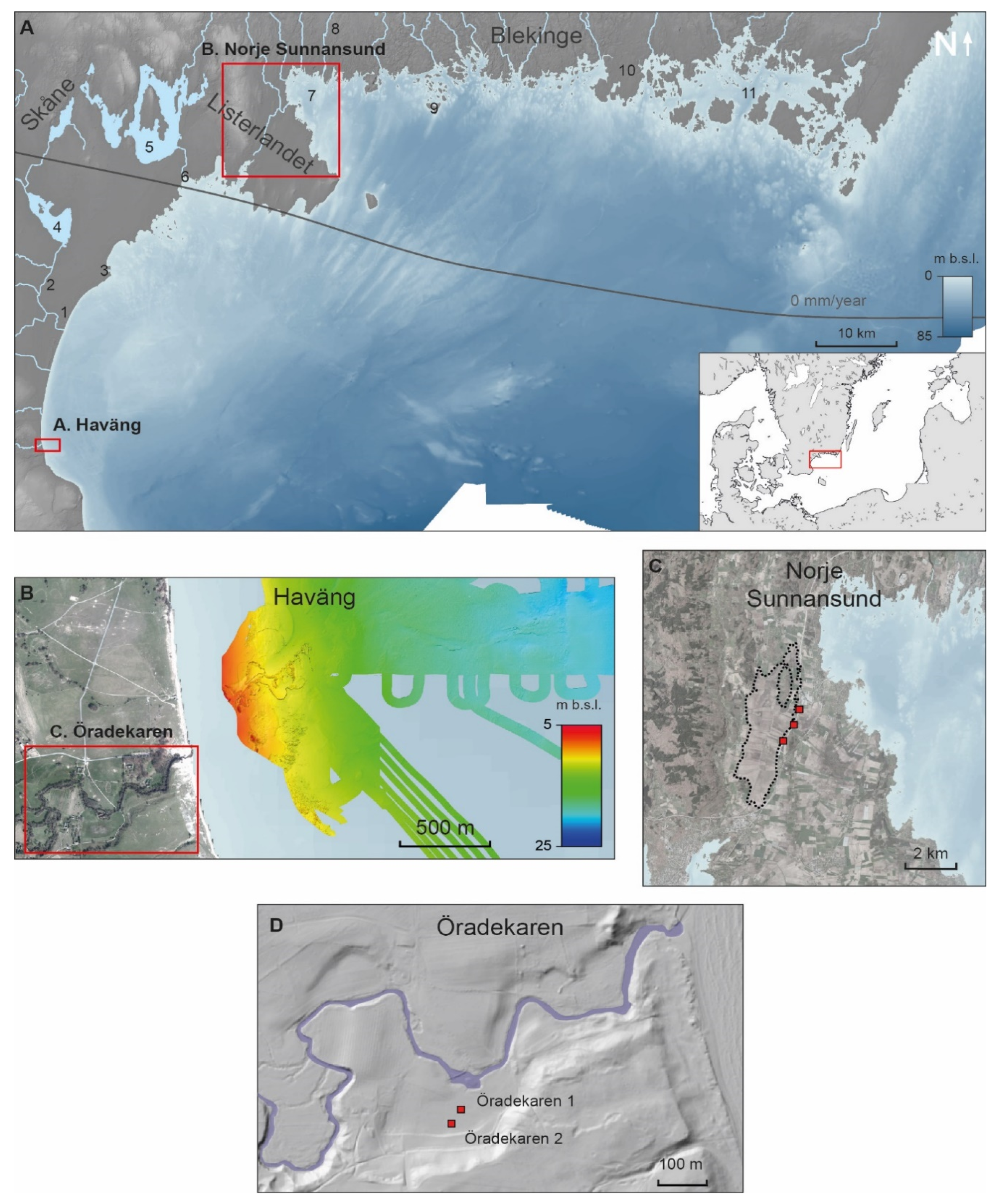
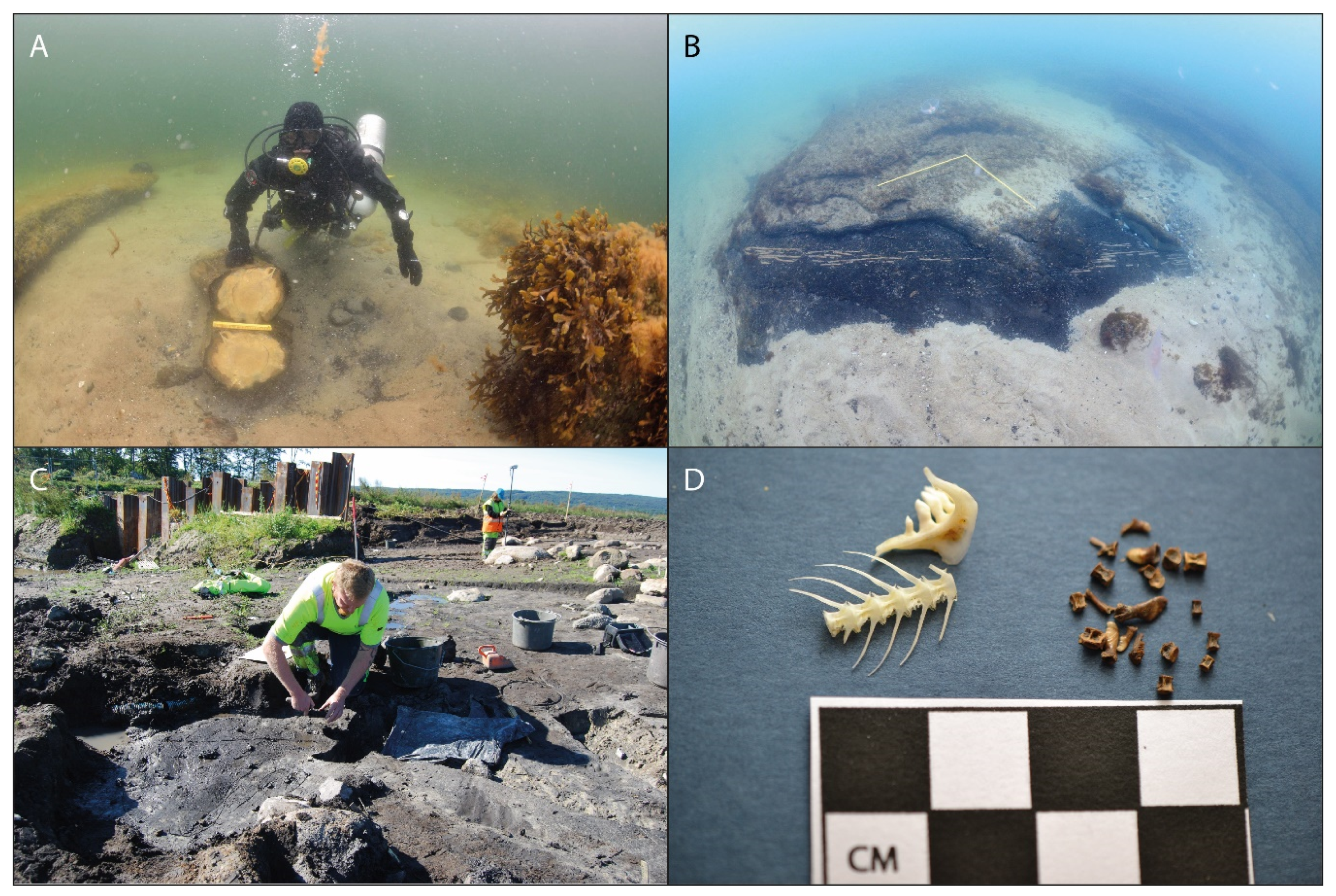
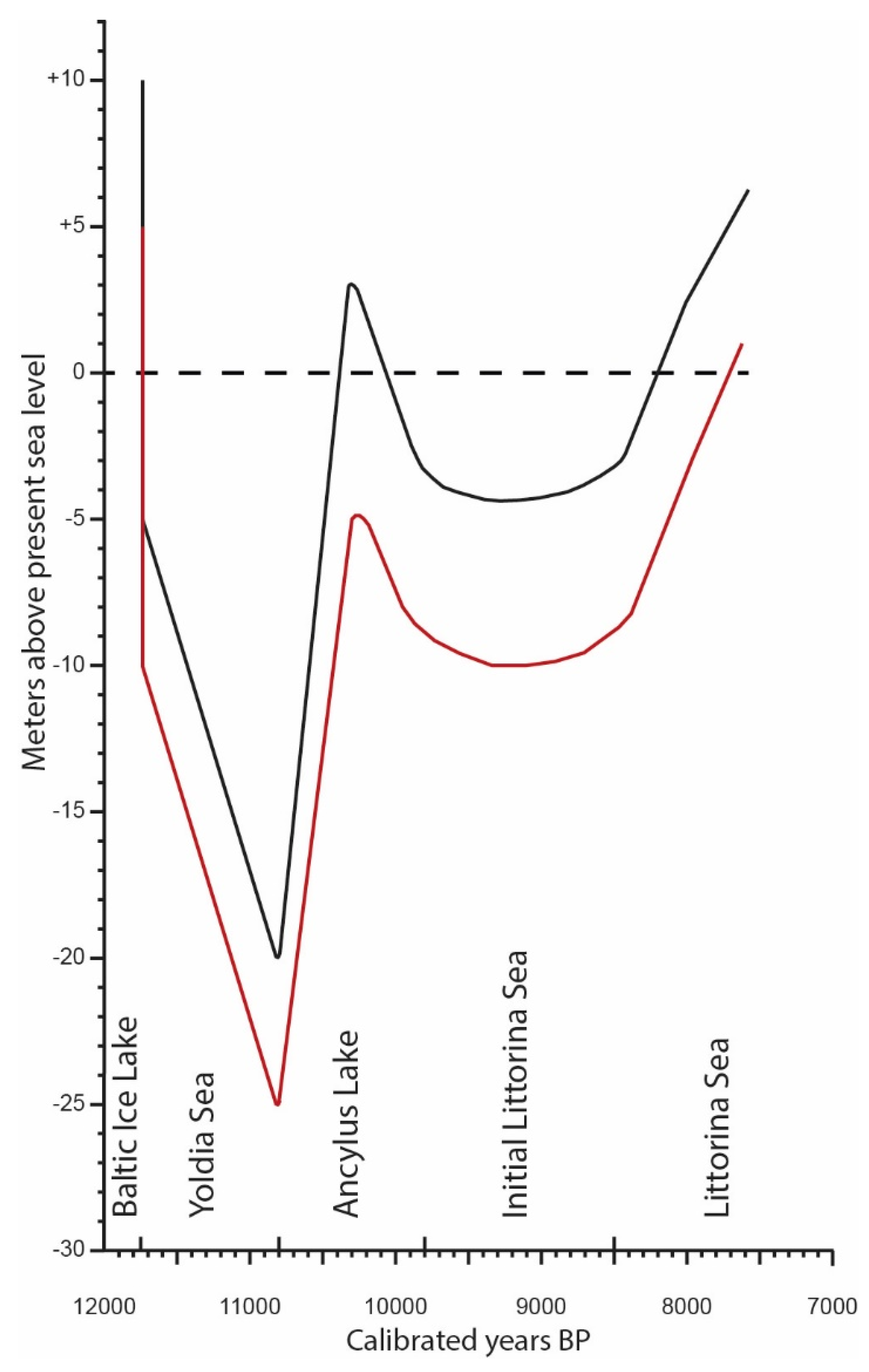
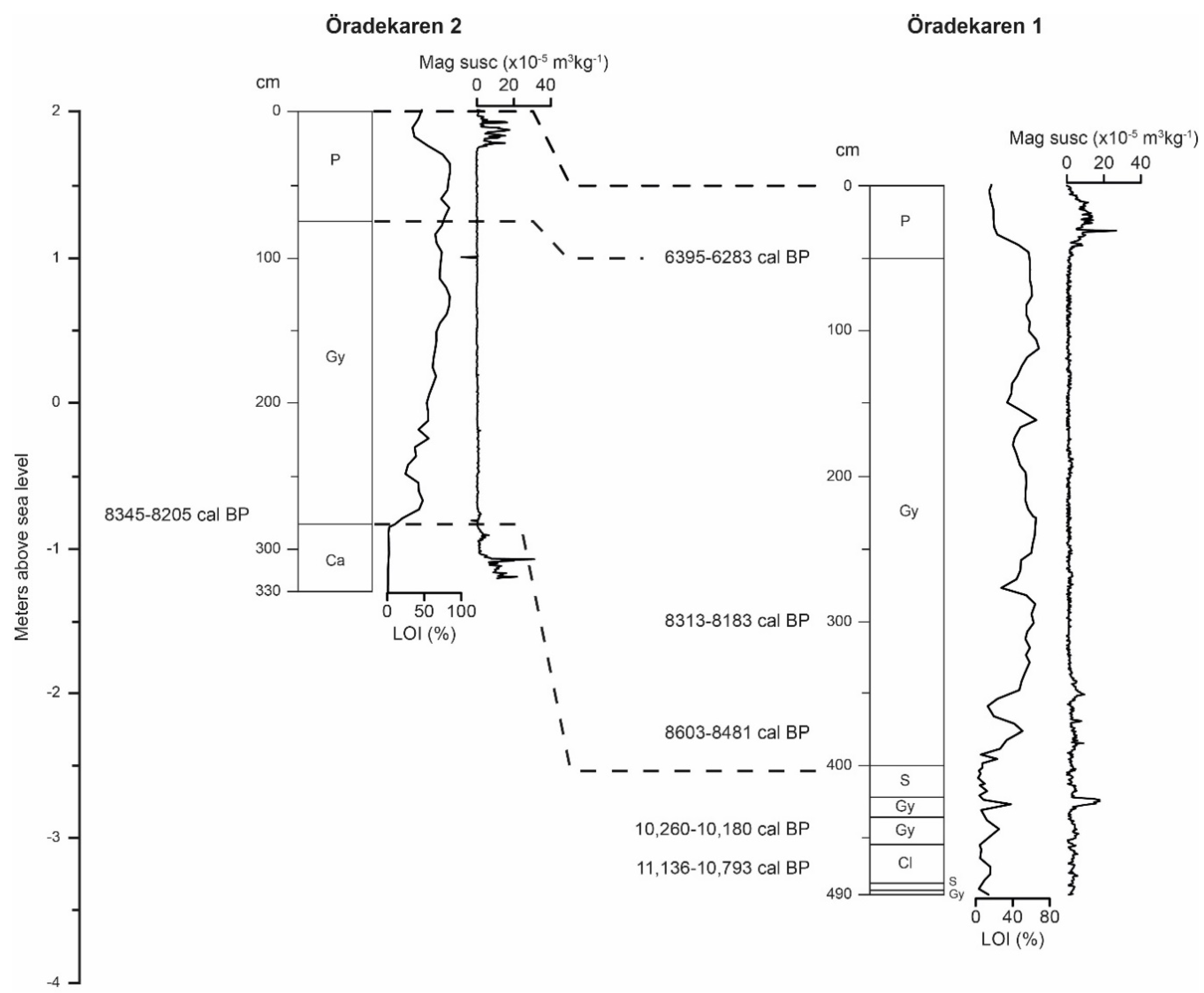
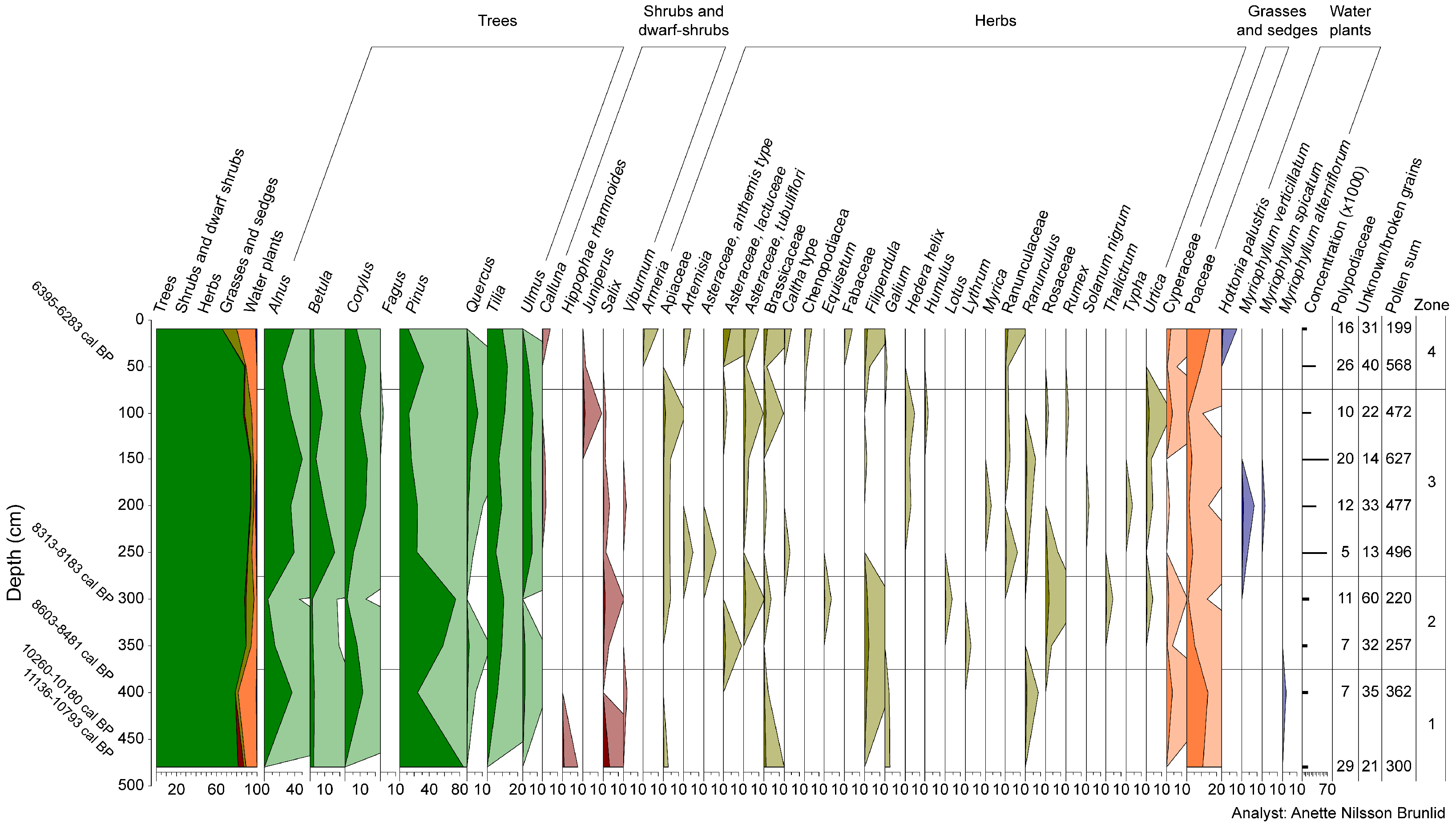
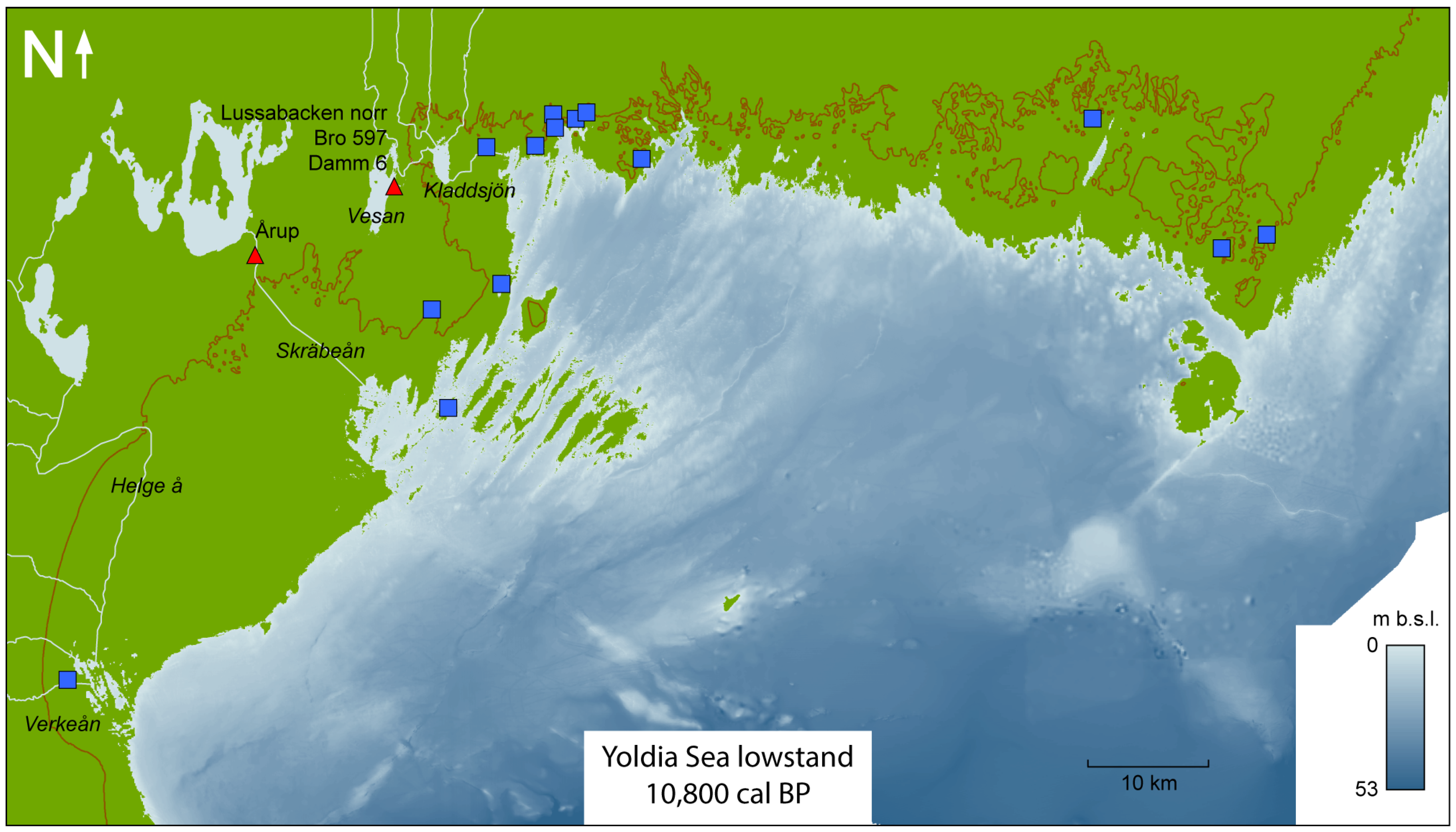
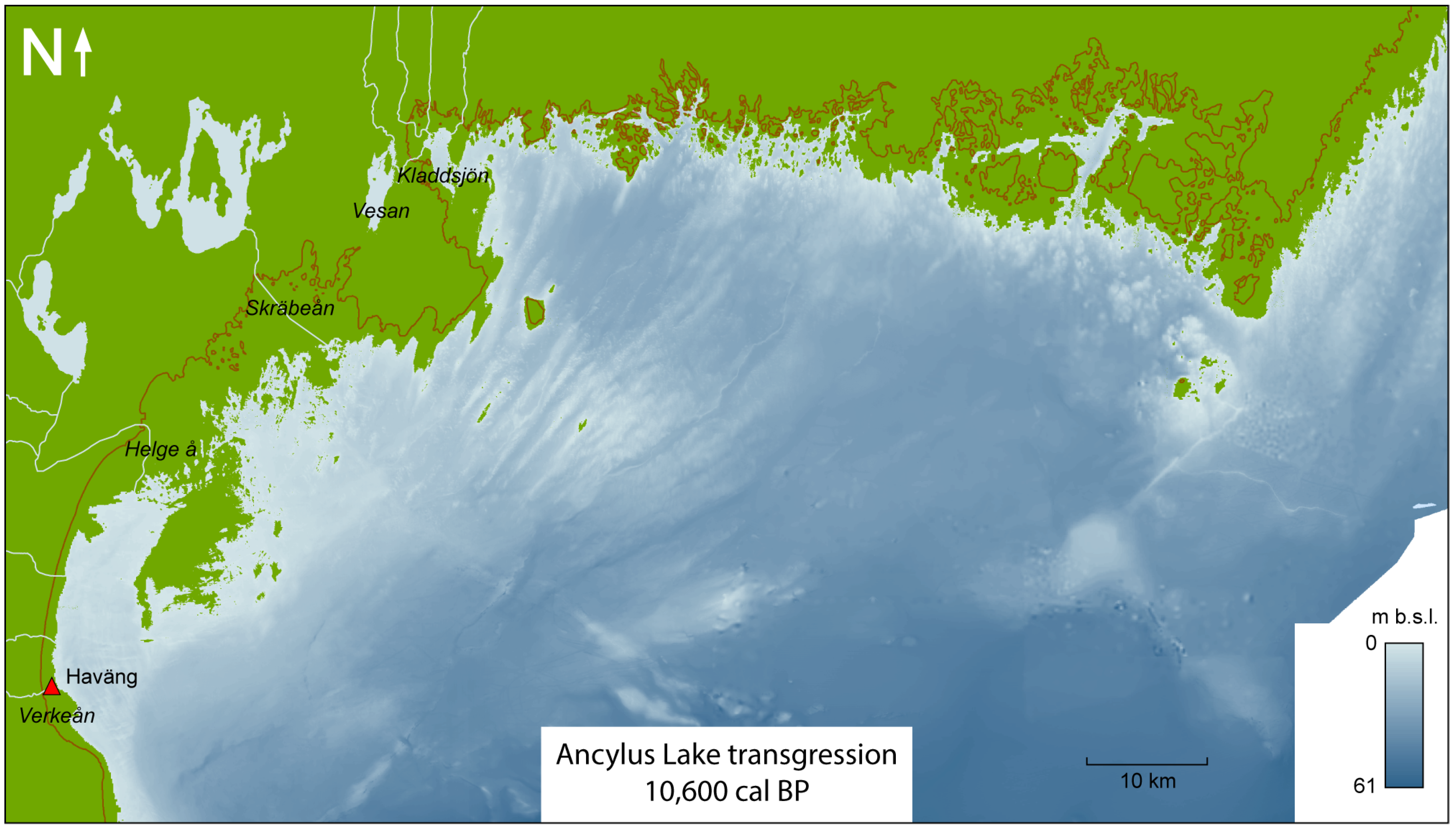
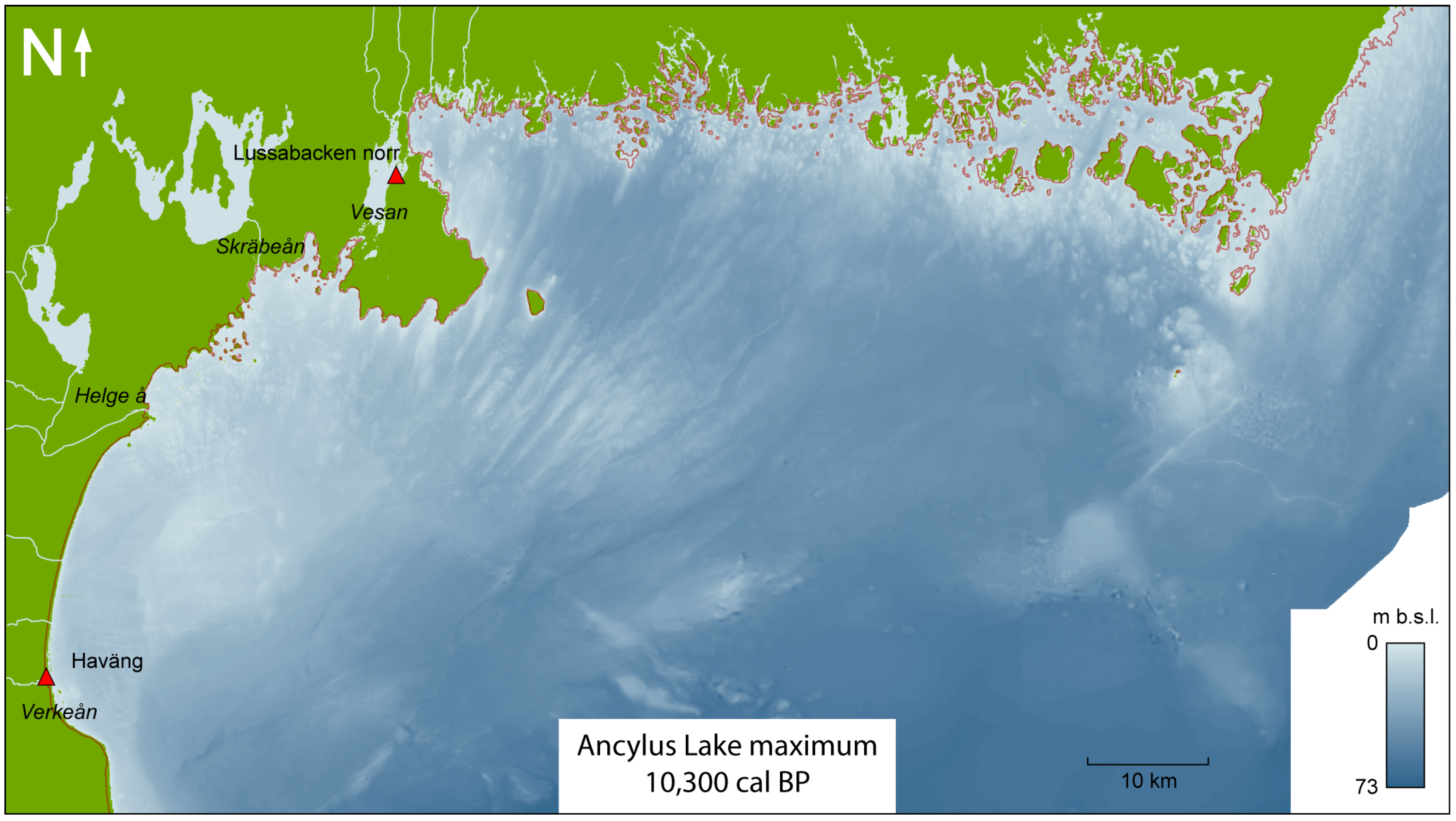
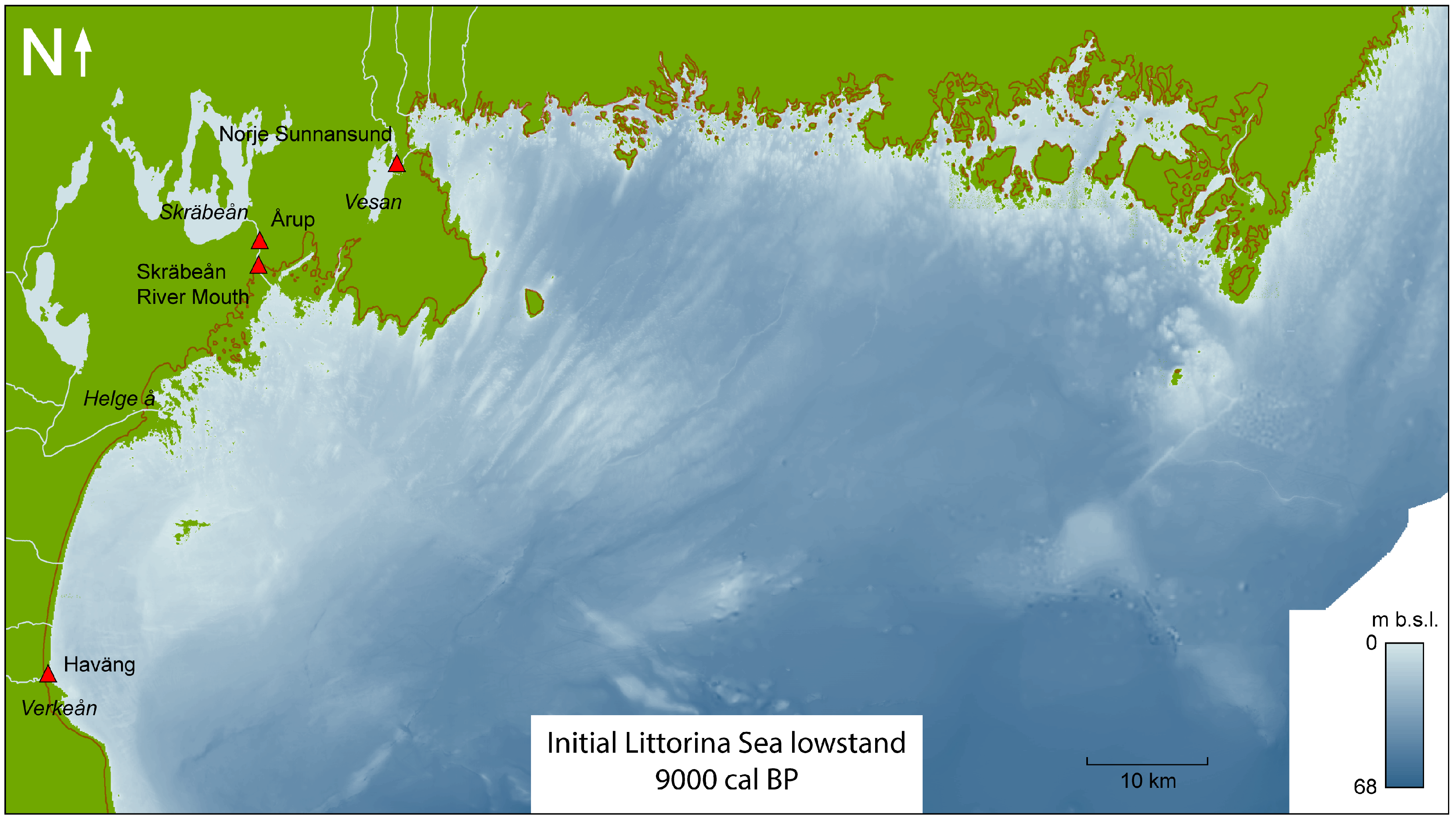
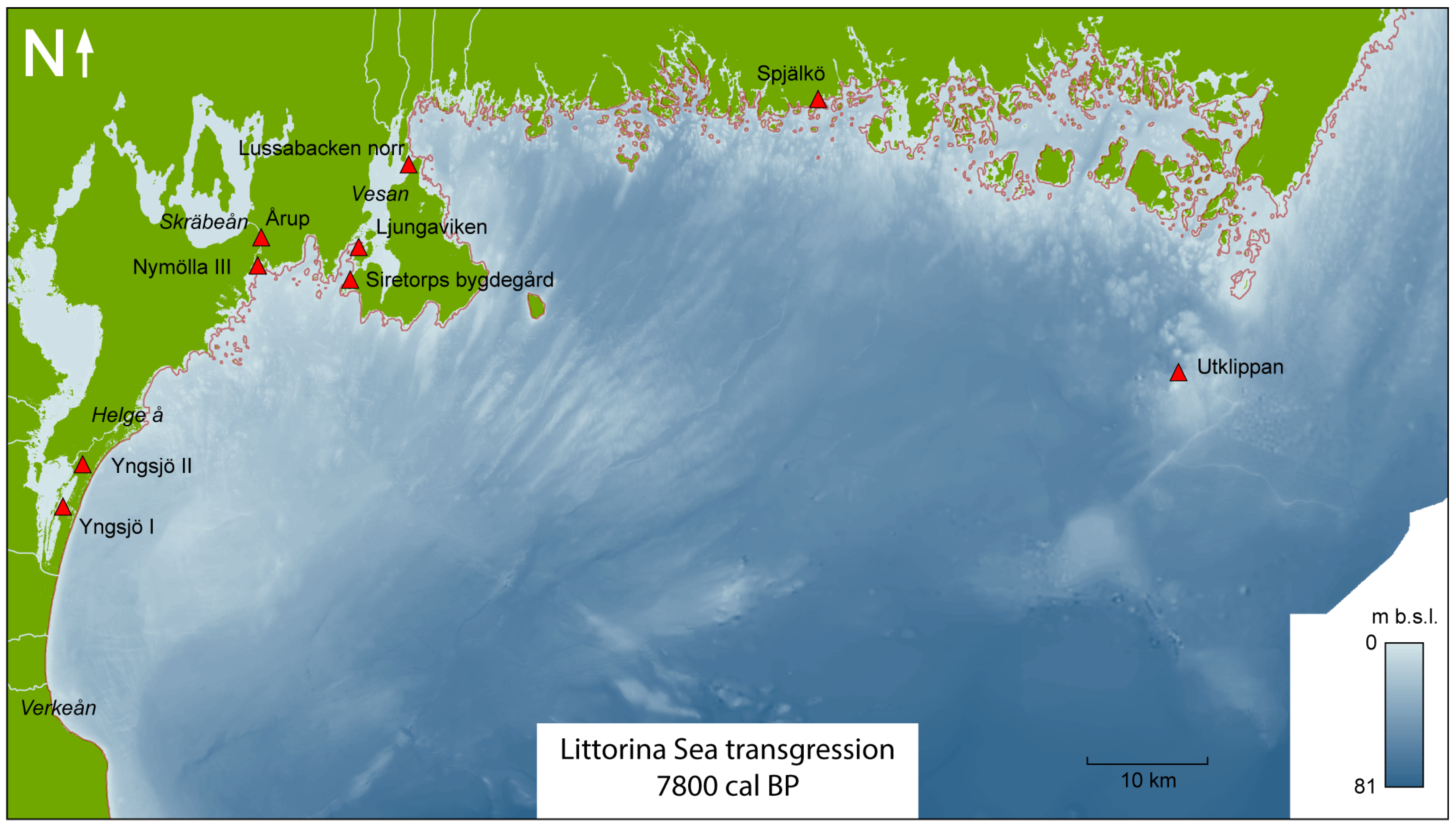
| Öradekaren 1 | |||
|---|---|---|---|
| Depth (cm) | Elevation (m a.s.l.) | Lithology | Description |
| 0–50 | 1.5–1.0 | Fen peat | Highly humified, plant remains, gradual lower boundary |
| 50–400 | 1.0–−2.5 | Fine detritus gyttja | Clastic layers at 392–393 cm and 150 cm, gradual upper boundary |
| 400–422 | −2.5–−2.72 | Fine to medium sand | Organic layer at 416–418 cm, sharp upper boundary |
| 422–436 | −2.7–−2.86 | Sandy gyttja | Occasional, thin layers of medium sand, gradual lower boundary |
| 436–455 | −2.86–−3.05 | Clayey gyttja | Compact, gradual upper boundary |
| 455–482 | −3.05–−3.32 | Silty clay | Occasional, thin layers of fine sand, layers of fine sand |
| 482–487 | −3.32–−3.37 | Fine sand | Fining upwards |
| 487–490 | −3.37–−3.40 | Sandy gyttja | Fine sand |
| Site Name | Lab ID | Depth (cm) | Elevation (m a.s.l.) | Material | 14C Age (14C yr BP) | Calibrated Age (cal yr BP, 1 σ) |
|---|---|---|---|---|---|---|
| Öradekaren 1 | LuS-11553 | 50 | 1.0 | Mixed terrestrial plant remains | 5520 ± 50 | 6395–6283 |
| Öradekaren 1 | LuS-11554 | 300 | −1.5 | Mixed terrestrial plant remains | 7410 ± 55 | 8313–8183 |
| Öradekaren 1 | LuS-12885 | 380 | −2.3 | Mixed terrestrial plant remains | 7780 ± 45 | 8603–8481 |
| Öradekaren 1 | LuS-12886 | 445 | −2.95 | Mixed terrestrial plant remains | 9060 ± 60 | 10,260–10,180 |
| Öradekaren 1 | LuS-11555 | 476–477 | −3.26 | Mixed terrestrial plant remains | 9615 ± 60 | 11,136–10,793 |
| Öradekaren 2 | LuS-11888 | 277–278 | −0.78 | Wood remains | 7460 ± 50 | 8345–8205 |
| Skräbeån River Mouth 1 | LuS-13892 | - | - | Antler, red deer | 7865 ± 50 | 8752–8589 |
| Öradekaren 2 | |||
|---|---|---|---|
| Depth (cm) | Elevation (m a.s.l.) | Lithology | Description |
| 0–74 | 2.0–1.26 | Fen peat | Layer of more humified peat at 11–25 cm |
| 74–284 | 1.26–−0.84 | Fine detritus gyttja | Plant remains, coarser grained at 284–220 cm |
| 284–330 | −0.84–−1.3 | Calcareous silt and clay | Shell fragments, fining upwards, layers of coarser material |
© 2019 by the authors. Licensee MDPI, Basel, Switzerland. This article is an open access article distributed under the terms and conditions of the Creative Commons Attribution (CC BY) license (http://creativecommons.org/licenses/by/4.0/).
Share and Cite
Hansson, A.; Boethius, A.; Hammarlund, D.; Lagerås, P.; Magnell, O.; Nilsson, B.; Nilsson Brunlid, A.; Rundgren, M. Shoreline Displacement, Coastal Environments and Human Subsistence in the Hanö Bay Region during The Mesolithic. Quaternary 2019, 2, 14. https://doi.org/10.3390/quat2010014
Hansson A, Boethius A, Hammarlund D, Lagerås P, Magnell O, Nilsson B, Nilsson Brunlid A, Rundgren M. Shoreline Displacement, Coastal Environments and Human Subsistence in the Hanö Bay Region during The Mesolithic. Quaternary. 2019; 2(1):14. https://doi.org/10.3390/quat2010014
Chicago/Turabian StyleHansson, Anton, Adam Boethius, Dan Hammarlund, Per Lagerås, Ola Magnell, Björn Nilsson, Anette Nilsson Brunlid, and Mats Rundgren. 2019. "Shoreline Displacement, Coastal Environments and Human Subsistence in the Hanö Bay Region during The Mesolithic" Quaternary 2, no. 1: 14. https://doi.org/10.3390/quat2010014
APA StyleHansson, A., Boethius, A., Hammarlund, D., Lagerås, P., Magnell, O., Nilsson, B., Nilsson Brunlid, A., & Rundgren, M. (2019). Shoreline Displacement, Coastal Environments and Human Subsistence in the Hanö Bay Region during The Mesolithic. Quaternary, 2(1), 14. https://doi.org/10.3390/quat2010014





